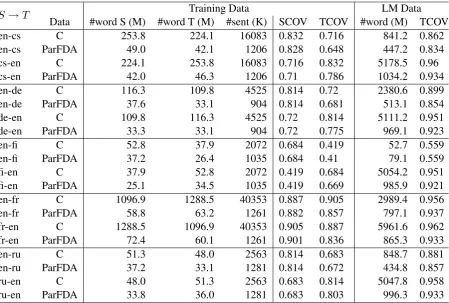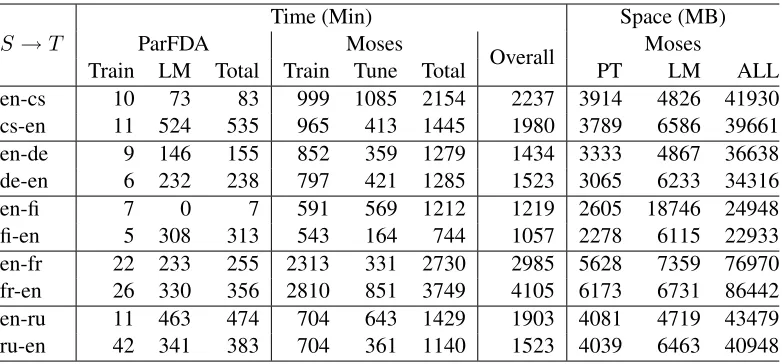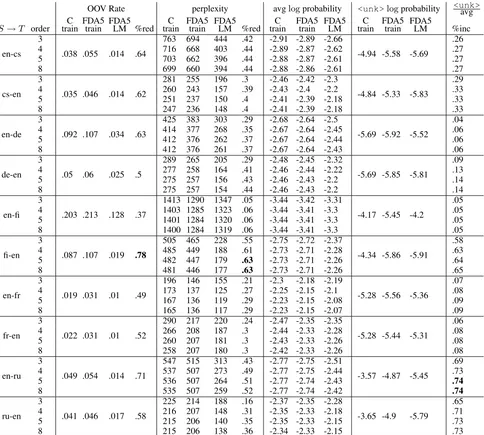ParFDA for Fast Deployment of Accurate
Statistical Machine Translation Systems, Benchmarks, and Statistics
Ergun Bic¸iciADAPT Research Center School of Computing Dublin City University, Ireland ergun.bicici@computing.dcu.ie
Qun Liu
ADAPT Research Center School of Computing Dublin City University, Ireland qliu@computing.dcu.ie
Andy Way
ADAPT Research Center School of Computing Dublin City University, Ireland away@computing.dcu.ie
Abstract
We build parallel FDA5 (ParFDA) Moses statistical machine translation (SMT) sys-tems for all language pairs in the workshop on statistical machine translation (Bojar et al., 2015) (WMT15) translation task and obtain results close to the top with an av-erage of3.176BLEU points difference us-ing significantly less resources for build-ing SMT systems. ParFDA is a paral-lel implementation of feature decay algo-rithms (FDA) developed for fast deploy-ment of accurate SMT systems (Bic¸ici, 2013; Bic¸ici et al., 2014; Bic¸ici and Yuret, 2015). ParFDA Moses SMT sys-tem we built is able to obtain the top TER performance in French to English translation. We make the data for build-ing ParFDA Moses SMT systems for WMT15 available:https://github. com/bicici/ParFDAWMT15.
1 Parallel FDA5 (ParFDA)
Statistical machine translation performance is in-fluenced by the data: if you already have the translations for the source being translated in your training set or even portions of it, then the transla-tion task becomes easier. If some token does not appear in your language model (LM), then it be-comes harder for the SMT engine to find its cor-rect position in the translation. The importance of ParFDA increases with the proliferation of train-ing material available for buildtrain-ing SMT systems. Table 1 presents the statistics of the available train-ing and LM corpora for the constrained (C) sys-tems in WMT15 (Bojar et al., 2015) as well as the statistics of the ParFDA selected training and LM data.
ParFDA (Bic¸ici, 2013; Bic¸ici et al., 2014) runs separate FDA5 (Bic¸ici and Yuret, 2015) models on
randomized subsets of the training data and com-bines the selections afterwards. FDA5 is avail-able athttp://github.com/bicici/FDA. We run
ParFDA SMT experiments using Moses (Koehn et al., 2007) in all language pairs in WMT15 (Bojar et al., 2015) and obtain SMT performance close to the top constrained Moses systems. ParFDA al-lows rapid prototyping of SMT systems for a given target domain or task.
We use ParFDA for selecting parallel training data and LM data for building SMT systems. We select the LM training data with ParFDA based on the following observation (Bic¸ici, 2013):
No word not appearing in the training set can appear in the translation.
Thus we are only interested in correctly ordering the words appearing in the training corpus and col-lecting the sentences that contain them for build-ing the LM. At the same time, a compact and more relevant LM corpus is also useful for modeling longer range dependencies with higher order n -gram models. We use3-grams for selecting train-ing data and2-grams for LM corpus selection.
2 Results
We run ParFDA SMT experiments for all lan-guage pairs in both directions in the WMT15 translation task (Bojar et al., 2015), which include English-Czech (en-cs), English-German (en-de), English-Finnish (en-fi), English-French (en-fr), and English-Russian (en-ru). We truecase all of the corpora, set the maximum sentence length to
126, use 150-best lists during tuning, set the LM order to a value in [7,10] for all language pairs, and train the LM using SRILM (Stolcke, 2002) with -unk option. For GIZA++ (Och and Ney, 2003), max-fertility is set to 10, with the num-ber of iterations set to 7,3,5,5,7 for IBM mod-els 1,2,3,4, and the HMM model, and 70 word
S →T Data #word S (M) #word T (M) #sent (K) SCOV TCOV #word (M) TCOVTraining Data LM Data
en-cs C 253.8 224.1 16083 0.832 0.716 841.2 0.862 en-cs ParFDA 49.0 42.1 1206 0.828 0.648 447.2 0.834 cs-en C 224.1 253.8 16083 0.716 0.832 5178.5 0.96 cs-en ParFDA 42.0 46.3 1206 0.71 0.786 1034.2 0.934
en-de C 116.3 109.8 4525 0.814 0.72 2380.6 0.899
en-de ParFDA 37.6 33.1 904 0.814 0.681 513.1 0.854
de-en C 109.8 116.3 4525 0.72 0.814 5111.2 0.951
de-en ParFDA 33.3 33.1 904 0.72 0.775 969.1 0.923
en-fi C 52.8 37.9 2072 0.684 0.419 52.7 0.559
en-fi ParFDA 37.2 26.4 1035 0.684 0.41 79.1 0.559
fi-en C 37.9 52.8 2072 0.419 0.684 5054.2 0.951
fi-en ParFDA 25.1 34.5 1035 0.419 0.669 985.9 0.921 en-fr C 1096.9 1288.5 40353 0.887 0.905 2989.4 0.956 en-fr ParFDA 58.8 63.2 1261 0.882 0.857 797.1 0.937 fr-en C 1288.5 1096.9 40353 0.905 0.887 5961.6 0.962 fr-en ParFDA 72.4 60.1 1261 0.901 0.836 865.3 0.933
en-ru C 51.3 48.0 2563 0.814 0.683 848.7 0.881
en-ru ParFDA 37.2 33.1 1281 0.814 0.672 434.8 0.857
ru-en C 48.0 51.3 2563 0.683 0.814 5047.8 0.958
[image:2.595.75.525.61.364.2]ru-en ParFDA 33.8 36.0 1281 0.683 0.803 996.3 0.933
Table 1: Data statistics for the available training and LM corpora in the constrained (C) setting compared with the ParFDA selected training and LM data. #words is in millions (M) and #sents in thousands (K).
classes are learned over 3 iterations with the mk-cls tool during training. The development set con-tains up to5000sentences randomly sampled from previous years’ development sets (2010-2014) and remaining come from the development set for WMT15.
2.1 Statistics
The statistics for the ParFDA selected training data and the available training data for the con-strained translation task are given in Table 1. For en and fr, we have access to the LDC Gigaword corpora (Parker et al., 2011; Graff et al., 2011), from which we extract only the story type news. The size of the LM corpora includes both the LDC and the monolingual LM corpora provided by WMT15. Table 1 shows the significant size differences between the constrained dataset (C) and the ParFDA selected data and also present the source and target coverage (SCOV and TCOV) in terms of the 2-grams of the test set. The quality of the training corpus can be measured by TCOV, which is found to correlate well with the BLEU performance achievable (Bic¸ici, 2011).
The space and time required for building the
ParFDA Moses SMT systems are quantified in Ta-ble 2 where size is in MB and time in minutes. PT stands for the phrase table. We used Moses ver-sion 3.0, fromwww.statmt.org/moses. Building
a ParFDA Moses SMT system can take about half a day.
2.2 Translation Results
ParFDA Moses SMT results for each translation direction together with the LM order used and the top constrained submissions to WMT15 are given in Table 31, where BLEUc is cased BLEU.
ParFDA significantly reduces the time required for training, development, and deployment of an SMT system for a given translation task. The average difference to the top constrained submission in WMT15 is 3.176 BLEU points whereas the dif-ference was3.49BLEU points in WMT14 (Bic¸ici et al., 2014). Performance improvement over last year’s results is likely due to using higher order
n-grams for data selection. ParFDA Moses SMT system is able to obtain the top TER performance in fr-en.
S→T ParFDA Time (Min)Moses Overall Space (MB)Moses Train LM Total Train Tune Total PT LM ALL en-cs 10 73 83 999 1085 2154 2237 3914 4826 41930 cs-en 11 524 535 965 413 1445 1980 3789 6586 39661 en-de 9 146 155 852 359 1279 1434 3333 4867 36638 de-en 6 232 238 797 421 1285 1523 3065 6233 34316 en-fi 7 0 7 591 569 1212 1219 2605 18746 24948 fi-en 5 308 313 543 164 744 1057 2278 6115 22933 en-fr 22 233 255 2313 331 2730 2985 5628 7359 76970 fr-en 26 330 356 2810 851 3749 4105 6173 6731 86442 en-ru 11 463 474 704 643 1429 1903 4081 4719 43479 ru-en 42 341 383 704 361 1140 1523 4039 6463 40948
Table 2: The space and time required for building the ParFDA Moses SMT systems. The sizes are in MB and time in minutes. PT stands for the phrase table. ALL does not contain the size of the LM.
BLEUc cs-en de-en Sfi-en→en fr-en ru-en en-cs en-de enen-fi→T en-fr en-ru ParFDA 0.204 0.2441 0.1541 0.3263 0.2598 0.148 0.1761 0.1135 0.3195 0.22 TopC 0.262 0.293 0.179 0.331 0.279 0.184 0.249 0.127 0.336 0.243 diff 0.058 0.0489 0.0249 0.0047 0.0192 0.036 0.0729 0.0135 0.0165 0.023
LM order 8 8 8 8 8 8 8 10 8 8
Table 3: BLEUc for ParFDA results, for the top constrained result in WMT15 (TopWMTC, from matrix.statmt.org), their difference, and the ParFDA LM order used are presented. Average difference is3.176BLEU points
2.3 LM Data Quality
A LM selected for a given translation task allows us to train higher order language models, model longer range dependencies better, and achieve lower perplexity as shown in Table 4. We compare the perplexity of the ParFDA selected LM with a LM trained on the ParFDA selected training data and a LM trained using all of the available training corpora. We build LM using SRILM with inter-polated Kneser-Ney discounting (-kndiscount -interpolate). We also use -unkoption to build open-vocabulary LM. We are able to achieve significant reductions in the number of OOV to-kens and the perplexity, reaching up to78% reduc-tion in the number of OOV tokens and up to63%
reduction in the perplexity. ParFDA can achieve larger reductions in perplexity than the 27% that can be achieved using a morphological analyzer and disambiguator for Turkish (Yuret and Bic¸ici, 2009) and can decrease the OOV rate at a similar rate. Table 4 also presents the averagelog prob-ability of tokens and the logprobability of token <unk>. The increase in the ratio between them in
the last column shows that OOV in ParFDA LM are not just less but also less likely at the same time.
3 Conclusion
We use ParFDA for solving computational scala-bility problems caused by the abundance of train-ing data for SMT models and LMs and still achieve SMT performance that is on par with the top performing SMT systems. ParFDA raises the bar of expectations from SMT with highly accu-rate translations and lower the bar to entry for SMT into new domains and tasks by allowing fast deployment of SMT systems. ParFDA enables a shift from general purpose SMT systems to-wards task adaptive SMT solutions. We make the data for building ParFDA Moses SMT systems for WMT15 available: https://github.com/ bicici/ParFDAWMT15.
Acknowledgments
OOV Rate perplexity avglogprobability <unk>logprobability <unk>avg S→T order trainC FDA5train FDA5LM %red trainC FDA5train FDA5LM %red trainC FDA5train FDA5LM trainC FDA5train FDA5LM %inc
en-cs 3
.038 .055 .014 .64
763 694 444 .42 -2.91 -2.89 -2.66
-4.94 -5.58 -5.69
.26
4 716 668 403 .44 -2.89 -2.87 -2.62 .27
5 703 662 396 .44 -2.88 -2.87 -2.61 .27
8 699 660 394 .44 -2.88 -2.86 -2.61 .27
cs-en 3
.035 .046 .014 .62
281 255 196 .3 -2.46 -2.42 -2.3
-4.84 -5.33 -5.83
.29
4 260 243 157 .39 -2.43 -2.4 -2.2 .33
5 251 237 150 .4 -2.41 -2.39 -2.18 .33
8 247 236 148 .4 -2.41 -2.39 -2.18 .33
en-de 3
.092 .107 .034 .63
425 383 303 .29 -2.68 -2.64 -2.5
-5.69 -5.92 -5.52
.04
4 414 377 268 .35 -2.67 -2.64 -2.45 .06
5 412 376 262 .37 -2.67 -2.64 -2.44 .06
8 412 376 261 .37 -2.67 -2.64 -2.43 .06
de-en 3
.05 .06 .025 .5
289 265 205 .29 -2.48 -2.45 -2.32
-5.69 -5.85 -5.81
.09
4 277 258 164 .41 -2.46 -2.44 -2.22 .13
5 275 257 156 .43 -2.46 -2.43 -2.2 .14
8 275 257 154 .44 -2.46 -2.43 -2.2 .14
en-fi 3
.203 .213 .128 .37
1413 1290 1347 .05 -3.44 -3.42 -3.31
-4.17 -5.45 -4.2
.05
4 1403 1285 1323 .06 -3.44 -3.41 -3.3 .05
5 1401 1284 1320 .06 -3.44 -3.41 -3.3 .05
8 1400 1284 1319 .06 -3.44 -3.41 -3.3 .05
fi-en 3
.087 .107 .019 .78
505 465 228 .55 -2.75 -2.72 -2.37
-4.34 -5.86 -5.91
.58
4 485 449 188 .61 -2.73 -2.71 -2.28 .63
5 482 447 179 .63 -2.73 -2.71 -2.26 .64
8 481 446 177 .63 -2.73 -2.71 -2.26 .65
en-fr 3
.019 .031 .01 .49
196 146 155 .21 -2.3 -2.18 -2.19
-5.28 -5.56 -5.36
.07
4 173 137 125 .27 -2.25 -2.15 -2.1 .08
5 167 136 119 .29 -2.23 -2.15 -2.08 .09
8 165 136 117 .29 -2.23 -2.15 -2.07 .09
fr-en 3
.022 .031 .01 .52
290 217 220 .24 -2.47 -2.35 -2.35
-5.28 -5.44 -5.31
.06
4 266 208 187 .3 -2.44 -2.33 -2.28 .08
5 260 207 181 .3 -2.43 -2.33 -2.26 .08
8 258 207 180 .3 -2.42 -2.33 -2.26 .08
en-ru 3
.049 .054 .014 .71
547 515 313 .43 -2.77 -2.75 -2.51
-3.57 -4.87 -5.45
.69
4 537 507 273 .49 -2.77 -2.75 -2.44 .73
5 536 507 264 .51 -2.77 -2.74 -2.43 .74
8 535 507 259 .52 -2.77 -2.74 -2.42 .74
ru-en 3
.041 .046 .017 .58
225 214 188 .16 -2.37 -2.35 -2.28
-3.65 -4.9 -5.79
.65
4 216 207 148 .31 -2.35 -2.33 -2.18 .71
5 215 206 140 .35 -2.35 -2.33 -2.15 .73
[image:4.595.74.558.61.496.2]8 215 206 138 .36 -2.34 -2.33 -2.15 .73
Table 4: Perplexity comparison of the LM built from the training corpus (train), ParFDA selected training data (FDA5 train), and the ParFDA selected LM data (FDA5 LM).%red is proportion of reduction.
(www.adaptcentre.ie, 07/CE/I1142) at Dublin City University and in part by SFI for the project “Monolingual and Bilingual Text Quality Judgments with Translation Perfor-mance Prediction” (computing.dcu.ie/ ˜ebicici/Projects/TIDA_RTM.html, 13/TIDA/I2740). We also thank the SFI/HEA Irish Centre for High-End Computing (ICHEC, www.ichec.ie) for the provision of computa-tional facilities and support.
References
Ergun Bic¸ici and Deniz Yuret. 2015. Optimizing in-stance selection for statistical machine translation
with feature decay algorithms. IEEE/ACM
Transac-tions On Audio, Speech, and Language Processing (TASLP), 23:339–350.
Ergun Bic¸ici, Qun Liu, and Andy Way. 2014. Paral-lel FDA5 for fast deployment of accurate statistical
machine translation systems. InProc. of the Ninth
Workshop on Statistical Machine Translation, pages 59–65, Baltimore, USA, June.
Ergun Bic¸ici. 2011. The Regression Model of Machine
Translation. Ph.D. thesis, Koc¸ University. Supervi-sor: Deniz Yuret.
Ergun Bic¸ici. 2013. Feature decay algorithms for fast deployment of accurate statistical machine
trans-lation systems. In Proc. of the Eighth Workshop
on Statistical Machine Translation, Sofia, Bulgaria, August.
Barry Haddow, Chris Hokamp, Matthias Huck, Pavel Pecina, Philipp Koehn, Christof Monz, Mat-teo Negri, Matt Post, Carolina Scarton, Lucia Spe-cia, and Marco Turchi. 2015. Findings of the 2015 workshop on statistical machine translation. In
Proc. of the Tenth Workshop on Statistical Machine Translation, Lisbon, Portugal, September.
David Graff, ngelo Mendona, and Denise DiPersio. 2011. French Gigaword third edition, Linguistic Data Consortium.
Philipp Koehn, Hieu Hoang, Alexandra Birch, Chris Callison-Burch, Marcello Federico, Nicola Bertoldi, Brooke Cowan, Wade Shen, Christine Moran, Richard Zens, Chris Dyer, Ondrej Bojar, Alexan-dra Constantin, and Evan Herbst. 2007. Moses: Open source toolkit for statistical machine
transla-tion. InProceedings of the 45th Annual Meeting of
the Association for Computational Linguistics Com-panion Volume Proceedings of the Demo and Poster Sessions, pages 177–180. Association for Computa-tional Linguistics.
Franz Josef Och and Hermann Ney. 2003. A sys-tematic comparison of various statistical alignment
models. Computational Linguistics, 29(1):19–51.
Robert Parker, David Graff, Junbo Kong, Ke Chen, and Kazuaki Maeda. 2011. English Gigaword fifth edi-tion, Linguistic Data Consortium.
Andreas Stolcke. 2002. SRILM - an extensible lan-guage modeling toolkit. InProc. Intl. Conf. on Spo-ken Language Processing, pages 901–904.
Deniz Yuret and Ergun Bic¸ici. 2009. Modeling mor-phologically rich languages using split words and
unstructured dependencies. In Proc. of the


